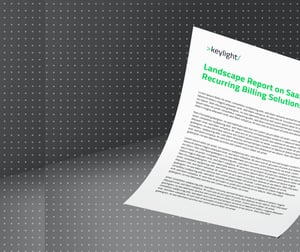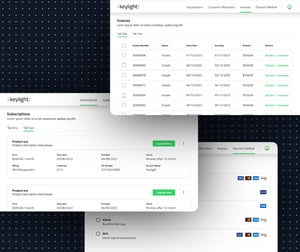Sales Operations & Technology for Subscription Businesses | Part One

PQ (Configure, Price and Quote), is a common tool used to simplify the sales process and increase efficiency to close deals. Plenty of companies use CPQ systems for creating quotations for different products and services, although in many businesses it's ultimately done manually.
In large and scaling businesses, however, CPQ becomes more complicated and needs integrated solutions that can handle complexity without compromising usability. In subscription businesses, where the goal is an ongoing relationship with the customer or partner, CPQ is part of an ongoing process rather than one defined by a beginning, middle and end. As a result, the requirements to solve are interconnected with other parts of the customer journey and may be repeated when upgrades and downgrades come into play.
At keylight, we include CPQ for subscription businesses as a standard feature of our system. In this article, we want to look at the role of CPQ, how it differs between subscription businesses and those based on one-off sales, and what an intelligent CPQ system needs.
Managing sales in B2B subscription businesses
As industries explore subscription business models, sales processes and mechanisms also need to transform away from one-off sales models, to leverage the full potential of the ongoing customer relationship. We can't try to fit old systems into new ways of working.
The interactions between prospects, sales teams and subscription systems are often overlooked when it comes to defining processes.
CPQ supports aligning individual sales goals with business objectives. The pre-defined product-pricing combinations, discount conditions, and rules not only prevent inaccurate quoting but also save time for approval processes.
Sales teams are considered the driving force for revenue generation, but there are other factors at play as well (partners, for example). For all involved in that process (sales representatives, partners and customers) it's important that platforms and systems are easy to use in order to facilitate sales in a timely manner and with accurate information for the end customer.
Selling challenges in subscription businesses
In subscription businesses, selling becomes complex because of the continuous introduction of new products/services and pricing structures. Rolling things out takes time, especially when at scale. Sales teams not only need time to adapt the sales messages, but also relearn the product specifics, pricing and discount rules for the quoting process.
Frontline sales teams need a full profile of the customer to manage relationships effectively, and sales management needs a clear overview of the sales operations for cost and efficiency. However, as the evolution of businesses plays out, there are many more customer touchpoints and data that have to be managed. It becomes challenging to manage that information and have a complete picture of the sales processes.
You need a system that gives sales the information they need to understand the customer, and the product, to know that quotes are accurate and to streamline the processes to close the deal smoothly. These can't be done manually in subscription businesses because errors would be made and the negotiation and approval processes could get out of hand in a continuous monetization framework, which is why there's a need for a dedicated system for subscription CPQ.
How traditional CPQ concepts inhibit subscription sales
Legacy CPQ systems are not built for subscription business models because their goal is different. Their aim is to save the seller time. However, when the relationship is ongoing (in a subscription business), so is the sales process. Therefore, your CPQ method needs to continuously update the selling strategies as well.
With subscriptions, the cost and quantity of a product are just one factor that goes into a mutually beneficial package offering. The selling process is complicated because you have different use cases for different markets. In addition, changes in sales strategies arrive all the time making it difficult to configure the most up-to-date information on quotes. Other complex dimensions of the selling and renewal process include things like the length of the service, customizable offerings, upgrades, downgrades and product and discount dependencies. This type of configuration is hard for traditional CPQ solutions, geared towards single sales, which means complex deals still get manually reviewed in many organizations.
In outdated subscription ecosystems, sales teams often struggle with:
- Sourcing data from multiple, disjointed systems or spreadsheets
- A complex product catalog and pricing structure
- Complex calculations for multiple offerings
- Long approval periods
- Possible errors in quotes
- Poor overview of the customer's past interactions
How CPQ can evolve for subscription businesses
CPQ is about more than just the product and its prices - it's about the bigger picture for the business and its overall, long-term profitability and sustainability.
CPQ should help the business to define when a subscriber uses a product. The pricing of a product or service influences customer usage, which heavily correlates with renewals and upsells. If the product/service is over or underpriced, it's no longer attractive to the customer.
A dedicated CPQ helps to tailor your offering to retain the attention of customers. It also helps to streamline other processes and relationships. Where legacy systems put finance first, subscription businesses should be experience-first. That means that pricing doesn't stand alone, but is intertwined with every other part of the buyer’s journey.
That's why it's important that the CPQ tool for subscription businesses provides easy access to accurate sales intelligence, automated workflows for approvals and other sales opportunities. In a subscription setting, CPQ is an integral part of the long-term customer relationship. It should be well-connected to the core business engine to streamline the customer experiences after closing, such as provisioning, and contract amendments, and well-incorporated into an ecosystem that evolves with time.
Prerequisites for an intelligent CPQ system
With all of this in mind, there are not only challenges to be resolved by having a purpose-created CPQ system in place for subscription businesses but also great benefits to be gained as well. Putting the right system in place requires a number of prerequisites. Four of the most important elements include the following:
Unified subscription data model
The key to a subscription business's success is connectivity between all areas of the organization. Central to that is an inbuilt CPQ capability that derives product rules and dependencies from one subscription engine to provide a complete end-to-end sales process solution in one scalable ecosystem.
Managed price effects
Manual pricing will only lead to delayed sales and errors. Businesses need a central pricing engine that allows sales professionals to concentrate on selling by providing pre-defined price rules. It's also important to have a flexible subscription system that can monetize any product and service combination. This clears the technical roadblocks that typically inhibit teams from rolling out experiments and transforming your quote-to-cash cycle into an automated flow.
Approval processes
Delays in the approval process give customers a poor experience and turn them off to the business and its offering. An automated system simplifies the approval process, configuring levels of approval for different roles, customer segments and transaction volume instead of having one person do it manually.
Flexible rules & conditions
While small businesses may manage legacy processes, automated, scalable CPQ ecosystems are essential for large organizations and those who plan to scale to a significant size. Having the right system in place simplifies the expansion process from a technical point of view. The system needs to be able to execute hybrid models for complex product combinations and layered user complexity with automated rules and conditions.
The issues and opportunities referenced in this article highlight the dynamic nature of the modern subscription contract and the need for sales and finance functions to evolve together. In our upcoming series of articles, we will expand on the topic of CPQ and guided selling, exploring the different factors that enable effective selling in subscription businesses.
Replace traditional engines with
a user-centric subscription system
Start now with >keylight/




